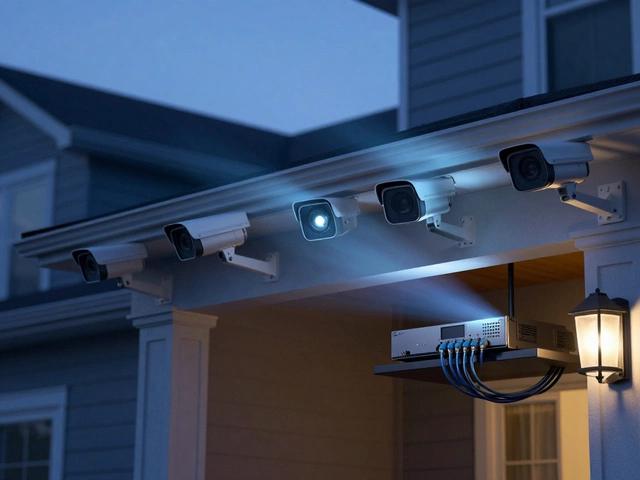When it comes to safeguarding your home, simply installing an alarm system isn't the final step in securing your sanctuary. The concept of alarm monitoring takes home security to a whole new level, ensuring continuous vigilance in the face of potential threats. The question is, does this extra layer of protection truly justify the expense for homeowners?
Picture this: You're miles away on vacation, your phone rings—a real-time alert from your home. Your heart races, imagining the worst. Here lies the allure of alarm monitoring, the assurance that someone else has your back when you can't be there. In this piece, we'll dive deep into alarm monitoring's world, balancing its costs with the peace of mind it offers. We'll navigate through the intricacies, from potential savings to its long-term benefits and help you figure out if this investment aligns with your priorities.
- Understanding Alarm Monitoring
- Weighing Costs and Benefits
- Potential Savings and Discounts
- Comparing DIY and Professional Systems
- Making the Right Choice for Your Home
Understanding Alarm Monitoring
At its core, alarm monitoring is not just about installing a device that blares an alert. It encompasses a comprehensive system where your security devices are linked to a central station that actively monitors for any signs of disturbance, whether it's a security breach, a fire, or even medical emergencies. These systems excel in protecting your home security by ensuring that someone is always on vigilance, ready to notify authorities or you of any irregularities.
Many homeowners find themselves weighing the necessity of monitored systems over standalone alarms. What's remarkable about monitored alarms is their capability to provide a nearly immediate response. When an alarm is triggered, a signal is sent to a monitoring center—the linchpin of this setup. Here, trained professionals assess the situation and take appropriate action, which could involve dispatching emergency services or contacting the homeowner directly.
How Does Alarm Monitoring Work?
Most alarm monitoring systems function via a series of components: sensors that detect intrusions (like motion detectors and window sensors), control panels, and communication infrastructures that bridge the gap between your home and the monitoring center. Depending on the sophistication of the system, it could use a landline, cellular network, or the internet to transmit signals.
Choosing the Right Monitoring Plan
When selecting a monitoring plan, it's crucial to consider how you want responders to handle alerts. Many companies offer multiple tiers and customizable options. Basic plans might cover essential intrusion and fire alerts, whilst more advanced ones can provide comprehensive surveillance, including video verification and advanced smoke detectors.
"Alarm monitoring offers unparalleled peace of mind, turning chaos into calm by ensuring quick action in times of crisis," says Jenna Price, a leading expert in home safety solutions.
Table below highlights typical response times and the technologies used in professional alarm monitoring systems:
| System Type | Response Time | Communication Method |
|---|---|---|
| Basic Monitoring | 15-30 seconds | Landline |
| Advanced Monitoring | Instantaneous | Cellular/Internet |
While the thought of strangers monitoring your home might seem intrusive, remember that alarm monitoring centers operate under strict privacy policies and are there solely to enhance your safety and investment.
The decision to employ an alarm monitoring service ultimately hinges on your personal needs and the level of security you desire for your home. As we explore further sections, we'll delve into whether the costs are highlighted by the benefits and potential savings that monitored systems can bring.
Weighing Costs and Benefits
When considering alarm monitoring for your home, it's essential to evaluate the costs against the substantial benefits it can offer. For some, the expense may initially seem daunting, but the reassurance obtained and the potential economic advantages could well justify the investment.
Initial and Ongoing Costs
Alarm monitoring services typically involve a monthly fee that can range from $20 to $60 depending on the provider and the level of service. This fee covers professional surveillance, with personnel available 24/7 to respond to alerts. In some cases, there might be an installation fee or equipment costs, especially if you’re coupling monitoring with a state-of-the-art security system.
However, some companies offer packages that include free installation, which might be appealing if you're budget-conscious. Moreover, some monitoring providers offer flexible plans that allow homeowners to only pay for what they need.
Benefits Beyond Security
One of the primary advantages of professional home security monitoring is peace of mind. Knowing that trained professionals are watching over your residence around the clock can relieve a considerable amount of stress, turning your home into a true fortress. During emergencies, such as break-ins or smoke detection, swift responses can prevent extensive damage and potential harm.
"The value of alarm monitoring services lies not just in preventing theft, but in providing families peace of mind," says Mary Smith, a home security expert at Secure Homes.
Financial Incentives
In addition to enhancing security, monitored systems can lead to financial benefits. Many insurance companies offer discounts for homes with active monitoring systems. These discounts vary but can range from 5% to 20% off annual home insurance premiums, significantly offsetting the cost of monitoring.
| Potential Savings | Discount Range |
|---|---|
| Insurance Discount | 5% - 20% |
| Prevented Theft Costs | $1,500 average per incident |
Comparing with DIY Systems
While DIY systems offer an upfront cost-saving advantage, they lack the professional oversight present in monitored systems. The latter guarantees immediate action if an alarm is triggered, which isn’t always possible with self-managed systems.
Ultimately, the choice between monitored and unmonitored systems should align with your priorities and lifestyle. If you frequently travel or live in a high-crime area, professional monitoring could be invaluable.
The decision to engage alarm monitoring services should balance both the tangible and intangible benefits. Understanding that investment in monitoring is an investment in your peace and safety may be the deciding factor for many homeowners.

Potential Savings and Discounts
In the vast realm of home security, alarm monitoring might initially seem like an extra burden on your budget. However, when you zoom in on the potential savings, the picture becomes far more appealing. Investing in an alarm monitoring system can, quite surprisingly, lead to substantial financial benefits that stretch beyond mere cost offsets.
Insurance Discounts
One of the most immediately tangible advantages of paying for alarm monitoring is the potential discount on homeowners insurance. Insurance companies recognize that a professionally monitored system reduces the risk of theft or damage, which significantly lessens the likelihood of a claim. Discounts can vary depending on providers but generally range between 10% to 20% of your premium. That amounts to savings that can effectively reduce, or even cover, the cost of monitoring services over time.
"Insurance providers place a premium on peace of mind, offering substantial discounts to homeowners who invest in monitored alarm systems," says Susan Thompson, a home insurance expert with over two decades of experience.
Preventing Costly Incidents
Beyond insurance savings, the predictive aspect of alarm monitoring can't be ignored. Consider the potential financial damage a burglary might cause in terms of stolen valuables, not to mention the emotional toll. By having a system in place that can prompt an immediate response—deterring or catching criminals—monitored systems can prevent these costly events altogether.
Long-Term Investment Gains
In addition to immediate savings, homeowners often find that investing in security systems adds value to their properties. As security technology advances, home buyers are increasingly factoring professionally monitored systems into their purchasing decisions. Thus, having an up-to-date, functioning alarm monitoring system could potentially bolster your home's resale value.
Other Perks and Bonuses
Finally, some companies offer promotional deals or additional perks, such as free equipment installation or complimentary months of service, further sweetening the pot when opting for alarm monitoring. Always keep an eye out for these opportunities, as they can dramatically impact the overall value proposition of the service.
Comparing DIY and Professional Systems
When it comes to choosing between a DIY alarm monitoring system and a professional system, homeowners face a decision that can greatly impact their security and budget. Each option offers unique advantages and potential drawbacks that can make or break the decision-making process.
DIY Systems
DIY alarm monitoring systems have gained traction over the years. They are attractive to tech-savvy individuals who appreciate a hands-on approach and are comfortable handling installation and setup. They're often touted for their cost-effectiveness and flexibility.
One of the key benefits of DIY systems is the low initial cost. You purchase the equipment, usually a basic set of sensors, a control panel, and perhaps a camera, and deploy it yourself. This means you avoid installation fees associated with professional setups. Additionally, many DIY systems come without monthly fees, making them appealing to those seeking to avoid recurring costs.
However, a potential downside is that DIY systems typically lack the constant vigilance provided by professional monitoring. While some systems offer app-based monitoring capabilities, if you miss notifications due to being asleep or busy, the responsibility of response rests entirely with you.
Common Features of DIY Systems
- Customizable components and add-ons
- Mobile alerts and push notifications
- Remote control through smartphone apps
- Potential integration with smart home devices
Professional Systems
Professional alarm monitoring systems are designed for those who prioritize safety and are willing to pay for peace of mind. These systems are installed by experts and monitored by trained personnel who can act swiftly during emergencies.
This option offers unparalleled convenience. When an alarm is triggered, the monitoring center is immediately notified. If necessary, they alert authorities or dispatch emergency services to your address. This rapid response can prove invaluable, especially when you're not available to respond yourself.
The major consideration here is cost. Professional systems typically involve monthly monitoring fees, which can range from modest to substantial depending on the service and provider. However, professional systems often result in reduced homeowner's insurance premiums, which can offset costs.
Common Features of Professional Systems
- 24/7 monitoring by security experts
- Automatic alerts to emergency services
- In-home consultations and custom installations
- Continuous system maintenance and upgrades
Which One to Choose?
The decision between DIY and professional systems hinges on your budget, lifestyle, and personal preference for control versus convenience. If you're budget-conscious and relish the challenge of managing your own security, a DIY system might align with your goals. Conversely, if you value a hands-off approach and peace of mind knowing professionals have your back, professional monitoring is the way to go.
Whichever you choose, both options are designed to enhance your home security, ensuring that when things go bump in the night, you'll be prepared.

Making the Right Choice for Your Home
Embarking on the journey to enhance your home's security is commendable, but choosing whether to invest in alarm monitoring can be daunting. Several factors should determine your decision, ranging from personal needs to budget constraints and even your home's geographic location.
Assessing Your Security Needs
First and foremost, consider what you aim to protect. Is it just property, or do you want a system that safeguards your family at all times? Homes situated in areas prone to break-ins may benefit more from professional monitoring, where every alert can be investigated in real-time, reducing false alarms.
Moreover, if you travel frequently or have a large property, an outsourced service could make a world of difference. After all, when one isn't home, having an ever-watchful eye ensures comfort and peace.
Evaluating Budget Considerations
Let's talk numbers. It's imperative to evaluate if professional monitoring fits into your financial plan. On average, fees can range from $20 to $60 per month. While it might seem costly upfront, balancing this against potential losses from theft—and discounts on home insurance—may sweeten the pot.
It's worthwhile to communicate with your insurance provider about potential deductions. Some companies offer discounts up to 20% for homes equipped with professional monitoring.
Geographical Influence
Our homes aren't isolated havens; they rest in broader communities with distinct security landscapes. Urban areas might see more benefit from immediate professional response due to faster service availability. In contrast, rural homes often experience lengthier response times, depending on the availability of local services.
Choosing the Best Provider
Naturally, if you opt for professional monitoring, choosing a reputable provider is crucial. Research various companies, compare customer reviews and service packages. Many top-tier providers offer trial periods, allowing a feel of their service without committing.
Additionally, verify the range of features on offer—smart home integration, mobile app accessibility, and 24/7 support enhance the return on investment.
In making the right choice, remember that your home is unique, necessitating a tailored approach to home security. Balancing affordability, effectiveness, and peace of mind ensures a fortified refuge you and your loved ones can trust.






